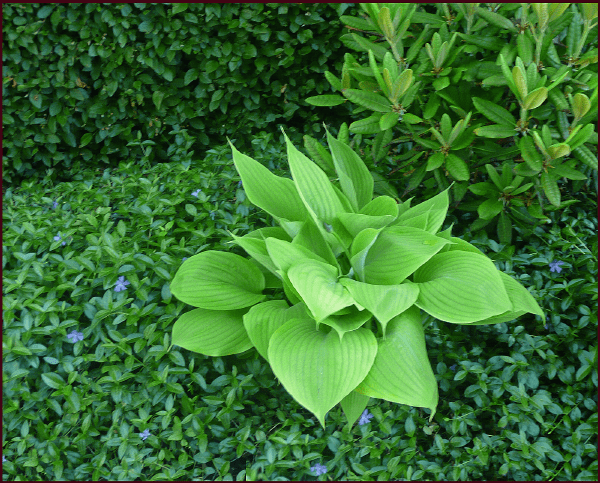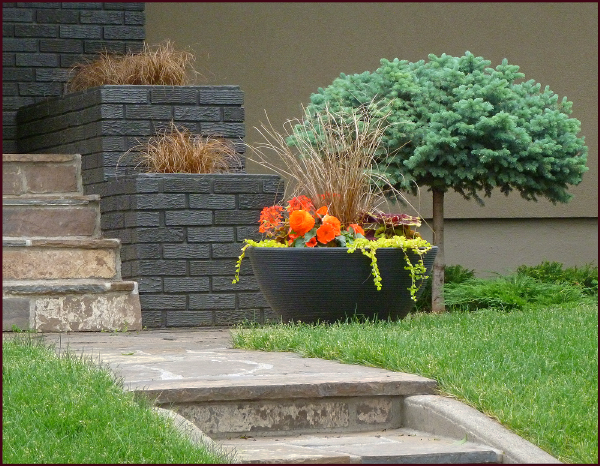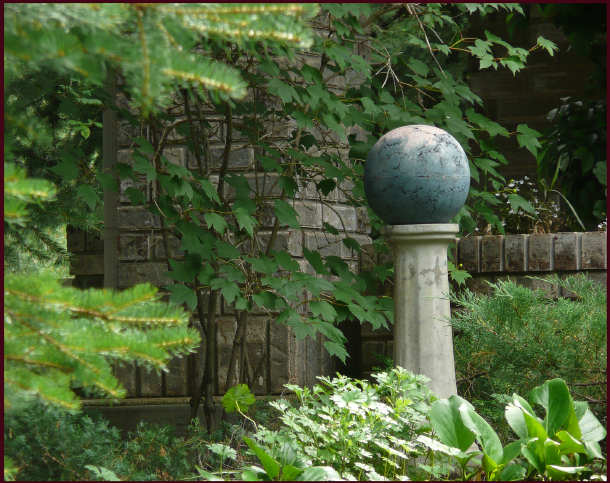Well here we are the last Monday of the month and time for your monthly measure of design doctrine. Last month, in Part 1 of this series, I discussed Unity in the garden and how it can be achieved using repetition. Continuing our discussion on Unity then, let’s look at the use of Dominance. By this I don’t mean standing over your plants, whip in hand, ordering them to behave themselves – nope, in fact a plant may get to do the dominating. Dominance occurs when one element or group of elements stands out or is more prominent than others. The dominant feature may be a plant, a design line or space, or a non-living element. It can be dominant by way of its size, its shape, its colour, its texture or because it is a Focal Point (a Focal Point refers to a non-living element such as a bird bath or fountain.)

Dominance in the landscape can result from larger size, coarser texture, stronger form, stronger colour or the existence of a focal point.

The arching purple branches of Berberis thunbergii ‘Rose Glow’ stand out against the softer greens of surrounding foliage. Photo: Pat Gaviller

A good design concept will have a hierarchy of spatial sizes with one dominant space. Here the lawn area in the centre is dominant as it is the largest design space.

The circular lawn area is the dominant space here because it contains the only arc in an otherwise angular concept.

The symmetrical planting (Hosta ‘Guacamole’ and Heuchera ‘Plum Pudding’) around this bird-bath enhances its role as focal point. Photo: Sue Gaviller
A garden devoid of any moments of emphasis can be visually unrestful as the eye tends to just wander. A dominant feature however will draw the eye and steady it, allowing it to rest. This is another concept that gardeners often intuit early on, but lose sight of later – myself included. When I purchased my first bird-bath and placed it in the garden, I indeed noted a more cohesive, restful composition – so I bought another. Then I found a beautiful earthenware bowl, filled it with water and nestled it amongst some groundcover in my shade garden. My husband asked me “What is it with you and round things filled with water?” Good question. The truth is I’d given in to the gardener’s favourite mantra “more is better” and rendered ineffective the dominance I’d unknowingly applied with the initial bird-bath. A single strong feature demands attention. Too many strong features compete for attention. This too can create unrest in the garden as the eye bounces around between competing elements.
Unfortunately there’s no dominance metre to tell us when enough is enough. Just keep in mind that the stronger the colour and/or the form, the more dominant it will be, hence the fewer of these elements your garden can support. For example, weeping standards such as Young’s weeping birch or Walker’s weeping Caragana, have very strong architectural form thus should always be used as single specimens, whereas vertical accents like columnar aspens or tall reed grasses, though still fairly dominant, can be repeated a couple of times or used in small groups. Warm vibrant colours like bright yellow or lime green will really draw the eye so should be used with some restraint whereas cooler, less intense colours can be used more generously.
The key is to use elements within your garden composition that are dominant for different reasons – maybe one has brilliant colour, another is a small group of very coarse textured plants and another has unique form. Or maybe there are several that are dominant because of their unique form but they are very different forms. While each one will draw the eye, they tend to lead the eye from one to another rather than rival each other. As well, a single dominant feature will often stand out for several reasons, for example it may be larger and more colourful and have unique form, making it particularly dominant. And you can help your focal point or feature tree take centre stage by surrounding it with more subdued elements.
Good placement of dominant features is also important. Anywhere the eye is naturally drawn, like the deepest part of a curve or through a visual opening, is an obvious spot to situate a strong feature. The space where design lines form a visual frame is another good location, as is an area you want to draw attention to – your front door for example. Remember too, that some of these elements – focal points or feature trees and shrubs – will have a presence in the winter as well, so make sure they are visually supported by other woody plant material. For more ideas on Focal Points and dominant plant forms as they are experienced in the winter months, check out a couple of my earlier posts: Focal Points in the Garden and Form Colour and Texture in the Winter Garden.

Malus ‘Rosyglo’, with its elegant form, takes centre stage in the foreground while Syringa prestoniae dominates the background. Note the placement of the two features – Malus is framed by the curving design line and Syringa is situated at the deepest part of the curve. Both are well staged by subdued plantings of Juniperus sabina cultivars. The junipers will serve as visual props for these features in the winter. Photo: Sue Gaviller

Hosta ‘Sum and Substance’ stands out because of its very coarse texture (large leaves) and its bright lime green colour. Photo: Sue Gaviller
While too many dominant elements in close proximity is bad design, there are scenarios where several strong features can be present together in a co-dominant relationship – for instance a vase shape tree with a bird bath in front of it. One may be slightly more dominant than the other but the effect is that they appear as a single focal vignette, not two competing entities.

A container filled with brightly coloured annuals is quite dominant on its own, as is the top graft Picea pungens ‘Glauca Globosa’, however because they are so different, their proximity to each other is mutually supportive rather than conflicting. Photo: Sue Gaviller
The dominant feature brings unity to the garden by subduing all other elements in its presence, hence unifying them in their shared secondary status.

A dominant feature like this gazing ball focal point, can pull together an otherwise nondescript scene, thus creating unity and harmony in the garden. Photo: Sue Gaviller
So go out and buy yourself a graceful weeping standard like Malus ‘Royal Beauty’ – but just one. Indulge yourself with that beautiful bird bath – but just one. You’ll see how creating areas of emphasis can bring about peace and harmony in your garden.
Yours, Sue





